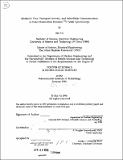Metabolic flux, transport activity, and subcellular communication in intact hearts from dynamic ¹³C NMR spectroscopy
Author(s)
Yu, Xin, 1964-
DownloadFull printable version (8.087Mb)
Advisor
E. Douglas Lewandowski.
Terms of use
Metadata
Show full item recordAbstract
The control of oxidative metabolism was studied using carbon-13 (13C) nuclear magnetic resonance (NMR) spectroscopy to determine the ratelimiting steps in 13C labeling of glutamate. 13C NMR spectra were acquired from isolated rabbit hearts perfused with either 2.5 mM [2- 13C] acetate or 2.5 mM [2- 13C] butyrate, and with or without KCl arrest. The tricarboxylic acid (TCA) cycle flux and the interconversion rate between (-ketoglutarate and glutamate were determined by least-square fitting of a kinetic model to NMR data. Rates were compared to flux through glutamate-oxaloacetate transaminase (GOT). Despite similar oxygen use, hearts oxidizing butyrate showed delayed incorporation of 13C label into glutamate and lower TCA cycle flux due to the influence of [beta]-oxidation: 8.0±0.2 [mu]moles/min/g dry weight with butyrate versus 10.5±0.4 with acetate at normal workload; 1.7±0.1 with butyrate versus 2.9±0.1 with acetate at potassium arrest (mean±SD). The interconversion rate between ca-ketoglutarate and glutamate ranged from 4.1±0.9 (butyrate+KC1) to 10.7±1.0 gmoles/min/g dry weight (acetate), at least 20-fold slower than the flux through GOT, and this proved to be the ratelimiting step in glutamate labeling. The results indicate that dynamic 13C NMR is sensitive not only to TCA cycle flux but also to metabolite transport rate across the mithochondrial membrane. To explore the effect of altered transport rates on the kinetics of glutamate labeling, metabolite exchange across the mitochondrial membrane was observed with 13C NMR spectroscopy in hearts oxidizing 2.5 mM [2- 13 C] butyrate at normal (no lactate) or high cytosolic redox state (2.5 mM lactate). High cytosolic redox state showed little effect on substrate utilization and TCA cycle activity. The TCA cycle flux was 9.7±0.5 [mu]moles/min/g dry weight with butyrate only and 10.2±0.3 with butyrate plus lactate. However, lactate induced a more than four-fold increase in the interconversion rate, from 3.1±0.2 gmoles/min/g dry weight to 14.3±2.0. These data indicate increased metabolite transport across the mitochondrial membrane due to stimulated malate-aspartate shuttle activity in response to elevated cytosolic redox state.
Description
Thesis (Sc.D.)--Massachusetts Institute of Technology, Dept. of Nuclear Engineering, 1998. Includes bibliographical references (leaves 98-109).
Date issued
1998Department
Massachusetts Institute of Technology. Department of Nuclear Science and EngineeringPublisher
Massachusetts Institute of Technology
Keywords
Nuclear Engineering